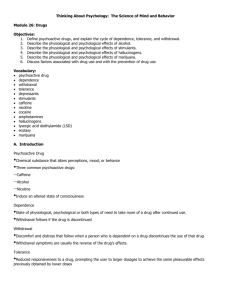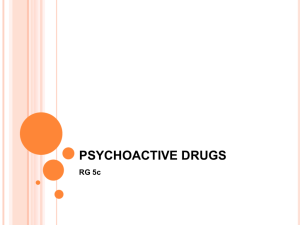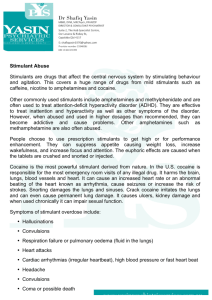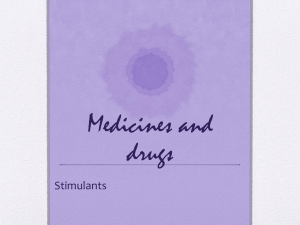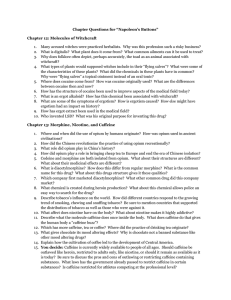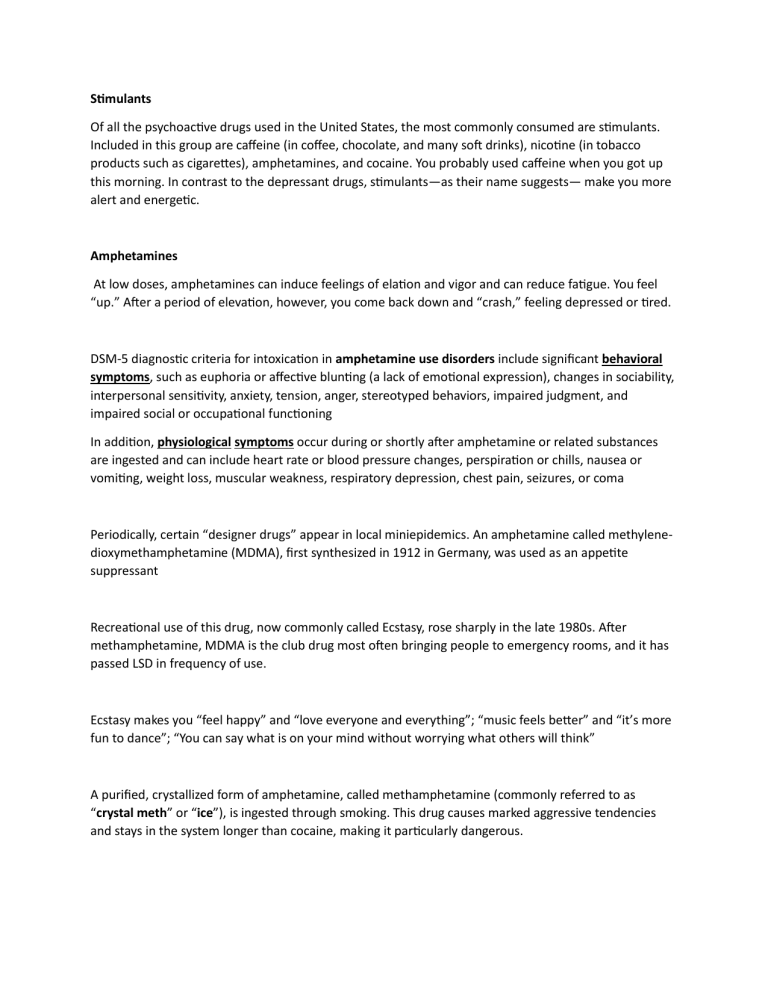
Stimulants Of all the psychoactive drugs used in the United States, the most commonly consumed are stimulants. Included in this group are caffeine (in coffee, chocolate, and many soft drinks), nicotine (in tobacco products such as cigarettes), amphetamines, and cocaine. You probably used caffeine when you got up this morning. In contrast to the depressant drugs, stimulants—as their name suggests— make you more alert and energetic. Amphetamines At low doses, amphetamines can induce feelings of elation and vigor and can reduce fatigue. You feel “up.” After a period of elevation, however, you come back down and “crash,” feeling depressed or tired. DSM-5 diagnostic criteria for intoxication in amphetamine use disorders include significant behavioral symptoms, such as euphoria or affective blunting (a lack of emotional expression), changes in sociability, interpersonal sensitivity, anxiety, tension, anger, stereotyped behaviors, impaired judgment, and impaired social or occupational functioning In addition, physiological symptoms occur during or shortly after amphetamine or related substances are ingested and can include heart rate or blood pressure changes, perspiration or chills, nausea or vomiting, weight loss, muscular weakness, respiratory depression, chest pain, seizures, or coma Periodically, certain “designer drugs” appear in local miniepidemics. An amphetamine called methylenedioxymethamphetamine (MDMA), first synthesized in 1912 in Germany, was used as an appetite suppressant Recreational use of this drug, now commonly called Ecstasy, rose sharply in the late 1980s. After methamphetamine, MDMA is the club drug most often bringing people to emergency rooms, and it has passed LSD in frequency of use. Ecstasy makes you “feel happy” and “love everyone and everything”; “music feels better” and “it’s more fun to dance”; “You can say what is on your mind without worrying what others will think” A purified, crystallized form of amphetamine, called methamphetamine (commonly referred to as “crystal meth” or “ice”), is ingested through smoking. This drug causes marked aggressive tendencies and stays in the system longer than cocaine, making it particularly dangerous. Cocaine The use and misuse of drugs wax and wane according to societal fashion, moods, and sanctions. Cocaine replaced amphetamines as the stimulant of choice in the 1970s. Cocaine is derived from the leaves of the coca plant, a flowering bush indigenous to South America. In his essay “On Coca” (1885/1974, p. 60), a young Sigmund Freud wrote of cocaine’s magical properties: “I have tested [the] effect of coca, which wards off hunger, sleep, and fatigue and steels one to intellectual effort, some dozen times on myself.” Clinical Description Like amphetamines, in small amounts cocaine increases alertness, produces euphoria, increases blood pressure and pulse, and causes insomnia and loss of appetite. Remember that Danny snorted (inhaled) cocaine when he partied through the night with his friends. He later said the drug made him feel powerful and invincible—the only way he really felt self-confident. The effects of cocaine are short lived; for Danny they lasted less than an hour, and he had to snort repeatedly to keep himself up. During these binges, he often became paranoid, experiencing exaggerated fears that he would be caught or that someone would steal his cocaine. Such paranoia—referred to as cocaine-induced paranoia—is common among persons with cocaine use disorders. Tobacco-Related Disorders DSM-5 does not describe an intoxication pattern for tobaccorelated disorders. Rather, it lists withdrawal symptoms, which include depressed mood, insomnia, irritability, anxiety, difficulty concentrating, restlessness, and increased appetite and weight gain. Nicotine in small doses stimulates the central nervous system; it can relieve stress and improve mood. But it can also cause high blood pressure and increase the risk of heart disease and cancer (Litvin et al., 2012). High doses can blur your vision, cause confusion, lead to convulsions, and sometimes even cause death. Once smokers are dependent on nicotine, going without it causes withdrawal symptoms. If you doubt the addictive power of nicotine, consider that the rate of relapse among people trying to give up drugs is equivalent among those using alcohol, heroin, and cigarettes Nicotine is inhaled into the lungs, where it enters the bloodstream. Only 7 to 19 seconds after a person inhales the smoke, the nicotine reaches the brain. Nicotine appears to stimulate specific receptors— nicotinic acetylcholine receptors (nAChRs)—in the midbrain reticular formation and the limbic system, the site of the brain’s pleasure pathway (the dopamine system responsible for feelings of euphoria) Smoking has been linked with signs of negative affect, such as depression, anxiety, and anger (Rasmusson, Anderson, Krishnan-Sarin, Wu, & Paliwal, 2006). For example, many people who quit smoking but later resume report that feelings of depression or anxiety were responsible for the relapse (Hughes, 2009). Caffeine-Related Disorders Caffeine is the most common of the psychoactive substances, used regularly by almost 90% of all Americans (Juliano & Griffiths, 2009). Called the “gentle stimulant” because it is thought to be the least harmful of all addictive drugs, caffeine can still lead to problems such as similar to that of other drugs (e.g., interfering with social and work obligations). This drug is found in tea, coffee, many cola drinks sold today, and cocoa products. High levels of caffeine are added to the “energy drinks” that are widely consumed in the United States today but are banned in some European countries (including France, Denmark, and Norway) due to health concerns As most of you have experienced firsthand, caffeine in small doses can elevate your mood and decrease fatigue. In larger doses, it can make you feel jittery and can cause insomnia. Because caffeine takes a relatively long time to leave our bodies (about 6 hours) As with the other psychoactive drugs, people react variously to caffeine; some are sensitive to it, and others can consume relatively large amounts with little effect. Research suggests that moderate use of caffeine (a cup of coffee per day) by pregnant women does not harm the developing fetus (Loomans et al., 2012) As with other stimulants, regular caffeine use can result in tolerance and dependence on the drug. Those of you who have experienced headaches, drowsiness, and a generally unpleasant mood when denied your morning coffee have had the withdrawal symptoms characteristic of this drug
